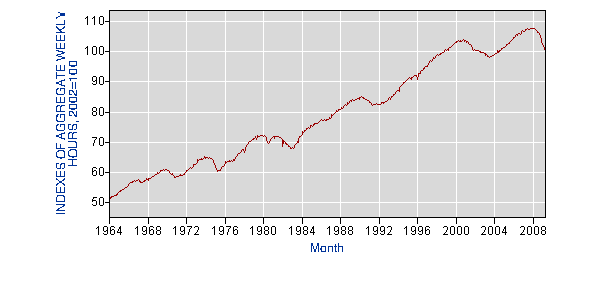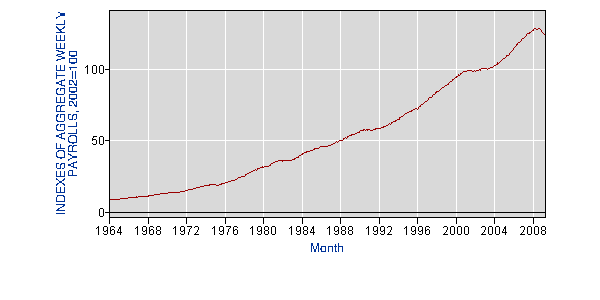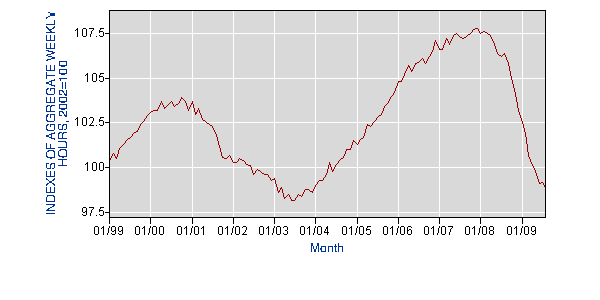Jeff Frankel, who is on the NBER Business Cycle Dating Committee (no it's not an E-Harmony subsidiary), makes a persuasive case that the index of Aggregate Weekly Hours Worked is a sensitive and important indicator for calling business cycle tops and bottoms. For example, the ends of the 1991 and 2001 recessions coincided exactly with upturns in this index. Unfortunately, despite all the sightings of "green shoots," reduced numbers of new unemployment claims filed, rationalizations that unemployment rates are lagging indicators, etc., the index of Aggregate Weekly Hours Worked declined in May at the same rapid rate seen since September (about 0.7% per month).
Aggregate Weekly Hours Worked equals the total number of private sector employees multiplied by the average length of the workweek for the average worker. Since labor is the largest input to goods and services, total economic output (GDP) necessarily tracks very closely to total hours worked.
On the other hand, the more frequently cited Aggregate Weekly Payrolls statistic tends to be distorted by lags in hourly wage rate changes, by severance pay, and by "labor hoarding." When orders dry up, employers tend to cut overtime, impose furloughs, and otherwise reduce the number of hours worked to avoid laying off employees. In a recovery, employers cautiously resume normal work schedules and overtime before they risk hiring new employees. Thus, total payroll dollars are not as responsive an indicator of total output of goods and services as is the index of total hours worked. Compare the volatility of one with the other in the following 2 graphs.

 Both data sets are in Table B-5 of the BLS Employment Situation Report, which is released within a week after the end of each month. Historical data and graphs, including the two above, are available here.
Both data sets are in Table B-5 of the BLS Employment Situation Report, which is released within a week after the end of each month. Historical data and graphs, including the two above, are available here.
Update on Wednesday, July 1, 2009 at 11:30AM by
 Skeptic
Skeptic
After studying the graph and data again and exchanging emails with Professor Frankel, I have to retreat and say I overrated the value of this metric. Although the Aggregate Weekly Hours index reached a cyclical bottom in May 1991, only one month after the official end of that recession, there was no such near coincidence in 2001. The index continued downward for another 17 months after the official end of the 2001 recession. What Prof. Frankel says was meaningful to him was that the rate of decline slowed in November 2001, and it did do that. I have not compared AWH index tops and bottoms with the beginnings and ends of earlier recessions.
This raises another question in my mind, and that is whether we can reasonably say a "recovery" is under way (measured by GDP) when hours worked are still declining. Martin Feldstein's answer in October 2003 was, There's No Such Thing As A 'Jobless" Recovery. He attributed the surge in productivity then to implementation of new information technologies. What might cause a similar dramatic increase in productivity at the end of the current recession?
Update on Wednesday, July 1, 2009 at 01:19PM by
 Skeptic
Skeptic
Since it appears that increasing productivity (equals output per hour of labor input) caused GDP to start rising while hours worked were still falling in the 2001 recession, it’s worth pondering what caused productivity gains. My first reaction was that offshoring by a company of whole departments or functions may increase the average productivity of the remaining domestic employees. For example, I’m familiar with a company that had revenues of about $100,000 per employee until it subcontracted to foreign suppliers 100% of its manufacturing function. Now it has one-tenth as many domestic employees and revenues of about $1,000,000 per employee. Of course, that’s not a ten-fold increase in productivity because the cost of goods sold has to be deducted. Nevertheless, the company’s gross margin increased (why else would it have made the change?), and it would seem value added per hour of in-house labor must have increased.
Others have been looking at this. Some examples: Houseman concluded, “Although it is impossible to fully assess the impact that mismeasurement and cost savings from outsourcing and offshoring have had on measured productivity growth in manufacturing, I point to several pieces of evidence that suggest it is significant, and I argue that these issues warrant serious attention.” Daveri and Jona-Lasinio concluded, “Overall, our statistical evidence shows a remarkably consistent pattern of correlation between offshoring and labour productivity growth with various statistical techniques. First of all, it appears that not all types of offshoring positively correlate with productivity growth. The type of good being outsourced indeed matters: the offshoring of intermediates is positively related to productivity growth, while the international outsourcing of services is either not related or - at times - even negatively related to productivity growth.” Olsen found, “The most apparent conclusion drawn from the review is that there appears to be no clear patterns as to how offshore outsourcing affects productivity, and that much depends on both sector and firm-specific characteristics.”
Perhaps the productivity increases of the early 00s had something to do with technology implementation, as Feldstein suggests, and perhaps also something to do with offshoring. These factors, and others, could tend to decouple hours worked from GDP, making it hard to be confident that the AWH index will accurately mark the bottom of the current Great Recession.
Update on Wednesday, July 29, 2009 at 08:15AM by
 Skeptic
Skeptic
Ben Bernanke explains in a town hall meeting organized and reported by The News Hour why the unemployment rate usually continues to rise after recovery from a recession has started. It's because population is growing and people are entering the workforce about 2.5% annually faster than retirements reduce the workforce. That continually increases the denominator in the equation Unemployment Rate = Number of Members of the Workforce Out of Work / Number of People in the Workforce. At the end of a recession, GDP usually starts to grow only slowly. So long as the annual rate of increase in GDP remains below 2.5% the calculated unemployment rate will still be increasing.
The significance of an upturn in GDP is that it sets a new trajectory, raises hopes, and encourages producers to take the risk of increasing production. But the collective economic misery of ordinary people continues to get worse until GDP per Workforce Member hits bottom.
Update on Friday, August 7, 2009 at 10:09AM by
 Skeptic
Skeptic
The AWH index was unchanged from June to July, according to today's BLS release. But don't crack open the champagne yet because declining industries far outnumbered rising industries. By far the biggest increase was in Motor Vehicles and Parts, +12.0% on a seasonally adjusted basis, but the index for that sector actually declined by 0.6% before seasonal adjustment. BLS explains that this industry normally has large summertime layoffs for retooling, but this year so many workers had already been laid off that the expected "seasonal" layoff was much smaller than usual. Without the uptick in the seasonally adjusted Motor Vehicle and Parts sector, the AWH for all private employment would have declined again, although not as much as in June. Jeff Frankell seems cautiously optimistic. Mark Thoma aggregates here many expert comments on todays employment report.
Update on Friday, September 4, 2009 at 07:52AM by
 Skeptic
Skeptic
After rising 0.1 percent from June to July, the seasonally adjusted AWH index declined again by 0.3 percent in August to 98.9. Compared with monthly declines averaging 0.7 percent from September through April, perhaps a shift to an average montly rate of decline of only 0.3 percent from May through August is the bottoming signal that Frankel is looking for, but look how noisy these data are. The index leveled off and gained a bit in July-August 2008, and then resumed a steep decline. The same thing happened October-December 2001.  Furthermore, as pointed out above and by Paul Krugman here, "[T]he purpose of stimulus is, first and foremost, to mitigate unemployment. The fact that the economy may be technically in recovery is irrelevant."
Furthermore, as pointed out above and by Paul Krugman here, "[T]he purpose of stimulus is, first and foremost, to mitigate unemployment. The fact that the economy may be technically in recovery is irrelevant."

Update on Friday, October 2, 2009 at 12:24PM by
 Skeptic
Skeptic
The downward trend in the AWH index resumed from August to September, declining from 99.0 to 98.5. The leveling from June to July looks like an aberration. We're nearing the 2003 low, which is very bad because now we have a substantially larger population. Other than 2003, one must look back more than 10 years to find a time when so little private sector work got done in the US.
Article originally appeared on realitybase (http://www.realitybase.org/).
See website for complete article licensing information.

 Both data sets are in Table B-5 of the BLS Employment Situation Report, which is released within a week after the end of each month. Historical data and graphs, including the two above, are available here.
Both data sets are in Table B-5 of the BLS Employment Situation Report, which is released within a week after the end of each month. Historical data and graphs, including the two above, are available here. Skeptic
Skeptic

